Seeing a new wall this past week made from two of the materials mentioned therein -- men and plastic -- in, of all places, New York's Wall Street section, I have reposted that blog below.

It was interesting to see a plastic wall being held by police officers surrounding Wall Street protestors. The nice thing about that kind of wall I suppose is, with their hands busy holding up a plastic wall, police officers are not able to use their clubs or pepper spray. Not to worry, however, their supervisors took care of that part.
***********************
(revised from original August, 2006 edition) I'd like to devote today's blog to walls. Walls are everywhere, but I seldom think about them. So let's start with one of my favorite walls. This one is one of many great walls in Taos, New Mexico, that are made of adobe. It's simple, yet elegant. I took this picture a couple of years ago when I thought it was in danger of being torn down. But thankfully it wasn't. It was just repaired and remains intact. I like it. (A 2010 visit revealed this wall has been torn down; a new faux adobe wall stands in its place.)
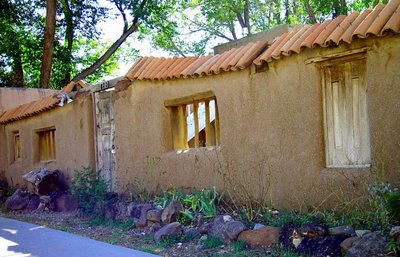 The job of this particular wall is to delineate private property from public property. As you walk along outside, it tells you, "Stay the hell out!" yet allows you to peek inside. That's nice.
The job of this particular wall is to delineate private property from public property. As you walk along outside, it tells you, "Stay the hell out!" yet allows you to peek inside. That's nice.Speaking of peeking through walls, there are new dressing room walls springing up at one of the stores of the English boutiques chain by Ann Summers. They sell lingerie among other items. This newly updated store will intentionally have walls with holes in them.
 According to an "Evening News" article, "cubicles in the new-look store will have small spy hole windows at eye-level. The idea is that women can throw open the peep hole, allowing their partners a peek at what they have to look forward to, without having to step out in front of other shoppers."
According to an "Evening News" article, "cubicles in the new-look store will have small spy hole windows at eye-level. The idea is that women can throw open the peep hole, allowing their partners a peek at what they have to look forward to, without having to step out in front of other shoppers."That's a nicely conceived wall. If they succeed in attracting more men into their stores as hoped, you can probably expect walls with holes to begin popping up eventually in American stores like Victoria's Secret.
There are walls designed to keep you out for your own protection. They keep you from getting too close to dangerous animals or falling into deep, sometimes sharp or hard places and killing yourself. As unbelievable as it may seem, there exist some people who still insist on feeding the bears by hand through such walls or leaning in just a little closer over them for a better shot of the canyon.
Walls can be made from many different things. Like the adobe, metal and sheet rock ones above, but here's an example of a wall made of much, much weaker and cheaper material which has proven to be far, far tougher than most walls. It'll remain that way so long as people have faith that yellow plastic ribbon with the word "Police" inscribed somewhere on it is very tough material. Thus far it has been.
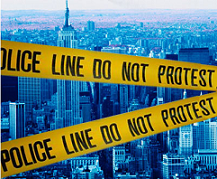 Another material often used in walls is people. These can be very strong also and usually prevail in protecting things like democrats and republicans while holding conventions behind walled gathering centers.
Another material often used in walls is people. These can be very strong also and usually prevail in protecting things like democrats and republicans while holding conventions behind walled gathering centers.On an even larger scale, human walls can be used to save the nation from undocumented immigrants coming through Mexico across our southern border. These have been far less successful. Maybe that's because immigrants are more passionate about their needs and less caring for their safety should they get caught in pursuit of those needs than their more comfortable and passive American counterparts.
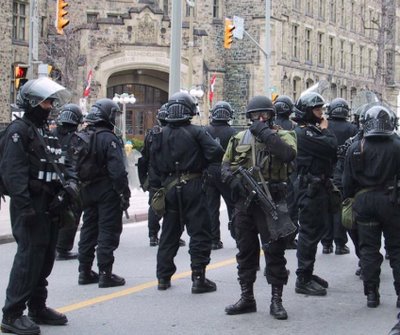 Oh sure, there were a few times when the human walls came close to failing here in the U.S. One such harrowing moment that immediately comes to mind is the 1968 democratic national convention in Chicago. There, unruly mobs gave police all they could handle. In 2004, a couple hundred thousand demonstrators outside the republican national convention, while unnerving in number, were basically peaceful, thus allowing those inside the convention to continue their agenda of ignoring popular demands.
Oh sure, there were a few times when the human walls came close to failing here in the U.S. One such harrowing moment that immediately comes to mind is the 1968 democratic national convention in Chicago. There, unruly mobs gave police all they could handle. In 2004, a couple hundred thousand demonstrators outside the republican national convention, while unnerving in number, were basically peaceful, thus allowing those inside the convention to continue their agenda of ignoring popular demands.While conventional walls of steel and concrete are strong, they are rigid and inflexible. Human walls are more fluid and unlike their non-human counterparts, can shoot guns. And when necessary, they can even "fall back" rather than be over-run.
However, it may help to remember in time all walls fail. It's just a question of when.
The biggest wall failure in recent history was the Berlin Wall which collapsed in 1989.
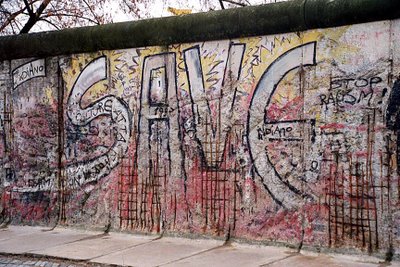 While it was originally designed and erected to keep people in, it also made a nice canvass for budding artists in need of self expression who were left "outside."
While it was originally designed and erected to keep people in, it also made a nice canvass for budding artists in need of self expression who were left "outside."Most walls are built to keep people out. The most spectacular example of that, of course, would be the Great Wall of China. Built in the Third Century, B.C., it stretched across 1,500 miles of China's northern border to discourage invaders from entering. But it failed in that purpose.
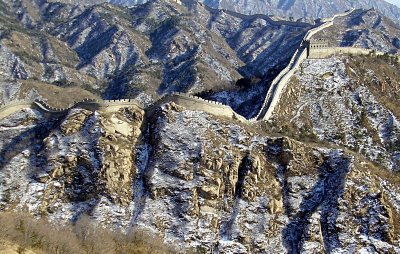 Today, however, the wall succeeds when used to draw people in--as a big old tourist attraction. It also continues in another unintended purpose, that of a source for construction workers to raid for building materials for other smaller walls and use in roadway paving.
Today, however, the wall succeeds when used to draw people in--as a big old tourist attraction. It also continues in another unintended purpose, that of a source for construction workers to raid for building materials for other smaller walls and use in roadway paving.Here's a couple examples of walls on far smaller scales. These that follow are similar to the Berlin Wall, i.e., designed to keep people in, not keep them out.
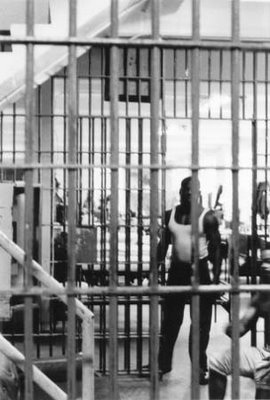 Here's a common, everyday prison. Prisons continue to propagate across the American landscape likes hordes of rabbits. As they expand in number, so does the percentage of Americans who have taken up residence behind their walls.
Here's a common, everyday prison. Prisons continue to propagate across the American landscape likes hordes of rabbits. As they expand in number, so does the percentage of Americans who have taken up residence behind their walls.While our current government often hides behind White House, Pentagon and congressional walls and halls to keep people away, more and more of the public is hoping to one day see these same government servants behind prison walls. To keep them away from us!
On an even smaller scale, there are the following little walls:
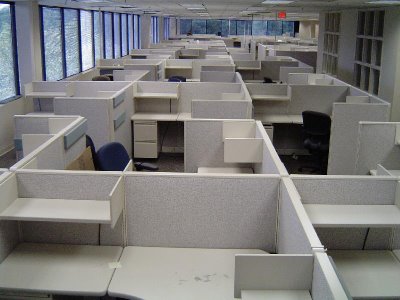 Scattered throughout America in corporate offices that have yet to move worker's jobs offshore are the walls of the fabled cubicles. (Sadly, this photo is from an office that has gone to India.)
Scattered throughout America in corporate offices that have yet to move worker's jobs offshore are the walls of the fabled cubicles. (Sadly, this photo is from an office that has gone to India.)I was fortunate to escape my job in corporate America before cubicles invaded our office. So I'm not sure what their exact purpose is. I really have no idea. Unless it's to dehumanize the workers behind them.
In my brief look at walls, these are probably the most touching ones. They are the walls erected to honor those who are no longer with us. Some represent policies of folly that took loved ones from us because of our national hubris.
 Other, less permanent walls, spring up immediately after a tragedy. Often made of flowers, notes to and photos of lost loved ones. The wall born of grief after 9/11 being the prime example.
Other, less permanent walls, spring up immediately after a tragedy. Often made of flowers, notes to and photos of lost loved ones. The wall born of grief after 9/11 being the prime example.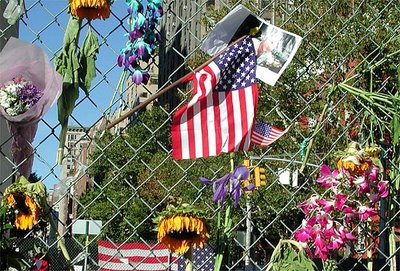
But I want to make a brief mention of probably the most prevalent walls of all. They are the strongest but often the most subtle of all walls. And they are very difficult for most to see. Not so much because they can't be seen, but because those living behind them are often very blind. Sorry, I don't have any pictures of them. They are the walls of dogma.
Established dogmas exist as unassailable beliefs. They are walls erected specifically for defense against anyone skeptical enough to question or doubt the belief systems (BS) they protect. I recently heard Naomi Klein refer to such walls as "intellectual police lines."
Perhaps the heartiest (and most significant) of these dogmatic walls are maintained by religions and their churches. I'll not focus on those here because of the heated passions they can provoke. If your passions are aroused by the mere mention of these institutions and my refusal to devote time to them, whether believer or cynic, you illustrate -- and should appreciate -- my point.
Religious dogma is closely followed by governments and their political party subsets, increasingly, multinational businesses and, not least of all, educational institutions and the academic experts who populate their hallways.
Governments give us pretty flags of colorful cloth to swear our allegiance to. Symbolizing our particular BS, if challenged to the extreme, one is obligated to kill or die for it in its defense.
Business provides us logos to wear on clothing or sport on the ass ends of our vehicles to proclaim our allegiances to them. Sometimes, as an arm of their government, they help write the national BS. Taken to the extreme like here in the U.S., business determines our BS by promoting fear and our reaction to it--wars -- but, hey, it's good for business.
Political parties give us symbols, like elephants and asses, and formidably exclude serious challenges from third parties and extremist views of members within their own. Mainstream media protect the BS of all of these.
And finally, educational institutions write our histories for us. Histories constructed under the prevailing paradigms of the day which in time congeal and harden into BS's of unassailable dogma such institutions purport to exist to refute.
While there are all kinds of walls, these are a few that come to my mind. From the most obvious to the most subtle and hardest to see. While serving many different purposes, in time they all will perish. Perhaps we should give thanks.

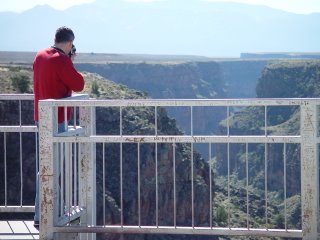

2 comments:
Great to reread this blog on walls. Agree the worst are probably the invisible ones. The homeless man with money enough for a meal meets an invisible wall when he tries to enter a "nice" restaurant. Then there are the invisible walls that keep families of color out of so called "white" neighborhoods. Thanks for pointing out the most harmful ones to those who haven't seen them before.
Anon: Thanks for the comment. You've opened my eyes even wider -- to the little walls overlooked herein; walls that are unseen, taken for granted, and encountered many times daily!
Post a Comment